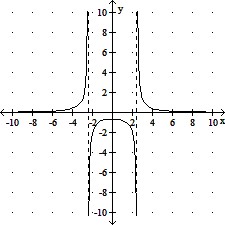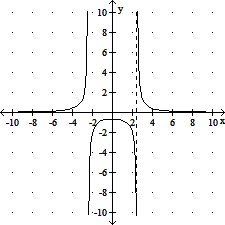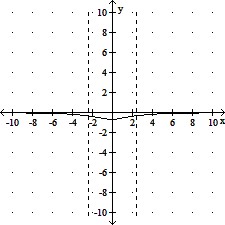Multiply. Use the special formula that applies.

A. x2 - 9x - 7
B. x2 + 9x - 7
C. x2 - 
D. x2 - 9
Answer: C
You might also like to view...
Identify the type of surface represented by the given equation. +
+  =
= 
A.
| Ellipsoid |
B. Elliptical cone
C. Hyperbolic paraboloid
D. Elliptical paraboloid
Solve the problem.If it has been determined that the probability of an earthquake occurring on a certain day in a certain area is  , what are the odds against an earthquake?
, what are the odds against an earthquake?
A. 1: 25 B. 23 : 1 C. 24 : 1 D. 25 : 1
Graph the rational function and find the intercepts.f(x) = 

A. No x-intercept. y-intercept: - 

B. No x-intercept. y-intercept: 

C. x-intercept = 0. y-intercept: - 

D. No x-intercept. y-intercept: 

Find the center, transverse axis, vertices, foci, and asymptotes of the hyperbola. -
-  = 1
= 1
A. center at (1, -2)
transverse axis is parallel to x-axis
vertices at (-5, -2) and (7, -2)
foci at (1 - 2 , -2) and (1 + 2
, -2) and (1 + 2 , -2)
, -2)
asymptotes of y + 2 = -  (x - 1) and y + 2 =
(x - 1) and y + 2 =  (x - 1)
(x - 1)
B. center at (1, -2)
transverse axis is parallel to y-axis
vertices at (1, -4) and (1, 0)
foci at (1, -2 - 2 ) and (1, -2 + 2
) and (1, -2 + 2 )
)
asymptotes of y - 2 = -  (x + 1) and y - 2 =
(x + 1) and y - 2 =  (x + 1)
(x + 1)
C. center at (-2, 1)
transverse axis is parallel to x-axis
vertices at (-4, 1) and (0, 1)
foci at (-2 - 2 , 1) and (-2 + 2
, 1) and (-2 + 2 , 1)
, 1)
asymptotes of y - 1 = - 3(x + 2) and y - 1 = 3(x + 2)
D. center at (1, -2)
transverse axis is parallel to x-axis
vertices at (-1, -2) and (3, -2)
foci at (1 - 2 , -2) and (1 + 2
, -2) and (1 + 2 , -2)
, -2)
asymptotes of y + 2 = - 3(x - 1) and y + 2 = 3(x - 1)